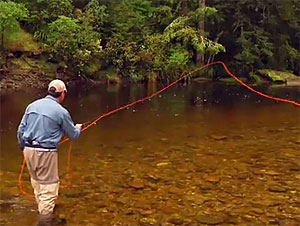The Dynamic Roll Cast
Have a question you want answered? Email it to us at [email protected].
Question: I know what a roll cast is (I think), but what’s a dynamic roll cast?
via email

Carl McNeil completes a dynamic roll cast. From the DVD “Casts That Catch Fish.”
Answer: The standard roll cast is one of the building blocks of fly fishing, and once you learn how to do it well, you can progress to a whole range of “dynamic” adaptations—which ultimately includes all of the Spey, Scandinavian, and Skagit casts. What makes a roll cast “dynamic” is that the line is in constant motion or stops only briefly during the cast.
For example, in the standard roll cast, when you angle your rod behind your shoulder to form the D-loop, everything comes to a stop, with your line resting on the water in front of you. In fact, if you’re roll-casting from the edge of a pond—and therefore are not dealing with current affecting your line—you can pause for as long as you want in this position before initiating the forward cast.
This works fine for many short-range applications with a floating line. What limits this cast is that the more line you have on the water and the longer it stays there, the more the very water tension that you use to load the rod becomes a force that you have to overcome to get the line moving again.
A dynamic roll cast attempts to make the “anchor point”—the line on the water—smaller and to keep it on the water for just a second, which doesn’t allow the surface tension to grab hold of the line with as much force. Whereas in a standard roll cast you drag the line through the water to form the anchor point, in a dynamic roll cast, you lift the line from the water, let it touch down briefly to form an anchor point, and then get it moving again.
This sounds more difficult than it really is, and once you’ve seen someone do it, the dynamic roll cast makes perfect sense. It requires practice to get the lift and the timing right, but once you do, you’ll find that you can roll-cast farther and more accurately. Your loop will also be tighter, looking more like a standard overhead cast.
Watch the video below to see how casting instructor Carl McNeil teaches the dynamic roll cast (he doesn’t actually identify it as such, but that’s what he’s doing).










